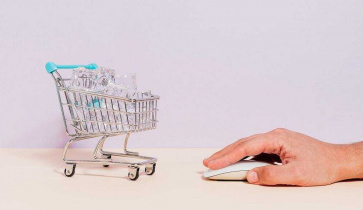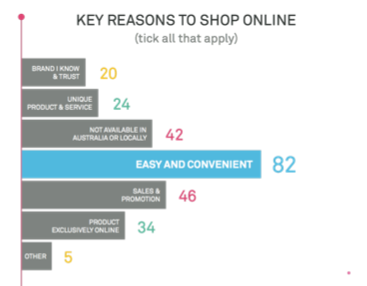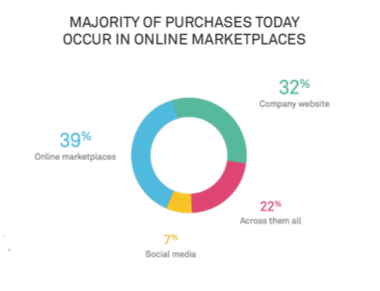
Ecommerce and Retail • Neto

If you’re an Australian retailer, you’re well aware the consumer landscape is changing rapidly. In fact, it’s evolving rapidly enough for several major research and advisory companies to produce yearly reports on the subject. Hidden in these reports, you’ll find a wealth of information you can use to adapt to the evolving ecommerce environment—if you’ve got time to read them all.
At Neto, we know you’re busy serving your customers, so we’ve worked through the reports ourselves to come up with a quick summary of their key points and, more importantly, what they mean for your business. And the news is good.
Nielsen reported that nearly all Australians who use the internet have made online purchases, and almost 25% of online Australians shop online at least once weekly. We recently conducted a survey with Telstra that found the number one reason Australians are shopping online is that it’s easy and convenient (82%), and buyers are also interested in accessing online promotions and sales (46%) or products that aren’t available locally (42%) or are exclusively online (34%). The future is bright for online retailers, and for traditional retailers looking to move into the ecommerce space.

Australians are shopping online all day long, with the start of the work day and throughout the evening proving to be slightly more popular than during the working day. However, different demographics show slightly different patterns in their ecommerce behaviours, which can help you more effectively target your audience.
For example, if you’re selling wine online, then the group most likely to purchase from you is the 60+ age group (26%). So you’ll want to make sure your paid advertising and social media posts aimed at this group are getting pushed out at the time they’re online and spending money, in this example, mostly between 9am and 12 pm.

Online marketplaces offer a simple way for customers to research prices for similar products across multiple retailers, and to bundle multiple purchases into a single transaction. Our study with Telstra revealed that 61% of online shoppers are using online marketplaces, either exclusively (39%) or in addition to companies’ own online stores (22%). Company websites are still a critical sales channel (32%) but if you’re not tapping into other channels as part of your strategy, you’re missing a significant opportunity.

Amazon hasn’t announced the Australian launch date, but they recently unveiled the location of their giant fulfilment centre in Melbourne, leading to speculation that operations will start anywhere from next month to early next year. Our study with Telstra revealed that one in three online shoppers intend to switch to Amazon, especially those looking for electronics and hi-fi equipment, clothing and fashion items, and gifts.

If you don’t have a plan for getting your store into the Amazon marketplace, it’s time to rethink your omnichannel strategy.
Australia has skipped ahead of most European countries when it comes to digital influence on the shopping journey, with our shoppers showing a similar profile to those in the much larger US and Canadian markets. Deloitte found that a remarkable 40% of in-store visits are influenced by digital, leading the UK by 13 percentage points. Australia also has one of the highest mobile influences on shopping, at 21%, second only to the US, resulting in conversion boosts of up to 25 percentage points. The implications are twofold: If you’re not considering your in-store sales when calculating your digital return on investment, you’re not recognising the true value of your digital investment. If you’re not considering your in-store audience as consumers of your digital campaigns, you’re missing a major part of your digital market.
Our study with Telstra found that 2 out of 3 respondents have purchased online after visiting a store to research a product, a behaviour that Deloitte also observed. For retailers, that opens up new opportunities for optimising the way you use your retail and warehouse spaces. Popular options include shipping products from the retail store, using retail stores as showrooms with a higher proportion of orders fulfilled directly from warehouses, or creating showroom space at the warehouse for customers to view products before ordering. Are your online customers getting the in-person customer service they want?
Online shoppers frequently turn to social media for help with their purchasing decisions, such as viewing YouTube reviews by independent third parties or seeking recommendations from friends on Facebook. Deloitte found that these independent or personal sources of information are considered more reliable that retailer advertisements or communications.

Sensis reported that the items most likely to be researched via social media are listed as electrical goods (46%), furniture and homewares (42%), clothing and fashion items (35%) and in more than half the cases (52%) the item was subsequently purchased. Deloitte also reported high digital influence in these verticals as well as in baby and toddler goods, automotive, books and entertainment, and wellness. Further, they found social media users were 26% more likely to buy.
That means all ecommerce retailers, and especially those in the listed market verticals, stand to boost their online revenue by making relevant content available on social media—and encouraging customers to share that content. Retailers may be able to gain further advantage by accepting payments via social media, an approach that PayPal reports is only being used by 7% of businesses.
Deloitte reports mobile commerce (mCommerce) figures that lag significantly behind eCommerce across all product verticals despite Australian mobile penetration estimated at 84%. Why? PayPal found the key barriers to mCommerce largely related to problems with mobile optimisation, such as long forms with too many fields or payment sites that don’t work seamlessly, as well as security concerns. While 71% of consumers use mobile devices to make payments, only 49% of Australian businesses are mobile optimised.

Further, the main driver is “ease of use”, meaning that mobile retail needs to offer something more over other ecommerce if it’s going to claim a larger market share. This convenience factor is likely to come from mobile apps that are targeted at specific user groups, which is why we’re seeing ecommerce platform vendors building white-labelled apps for their retailers to customise.
The full reports contain more detail about specific product verticals and demographic groups, so if you have the time, it’s worth a deep dive. But our list of key results should help you get started with optimising your business and making better use of digital assets for a bright ecommerce future.
Neto is the only Australian retail management platform that provides a complete solution for ecommerce, point of sale, inventory, and fulfilment. Our integrated back-end technology enables exceptional and consistent customer experiences via any channel, be it in-store, online, mobile, or through a marketplace. We automate repetitive tasks and integrate with multiple sales channels to manage orders and shipments.
Now that Amazon has launched, you maybe wondering what does this mean for your business? Get in-the-know with our Free Amazon Guide.
